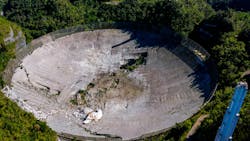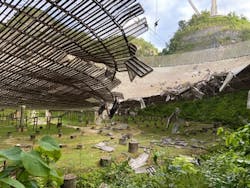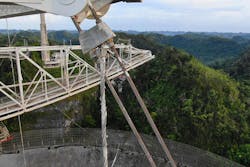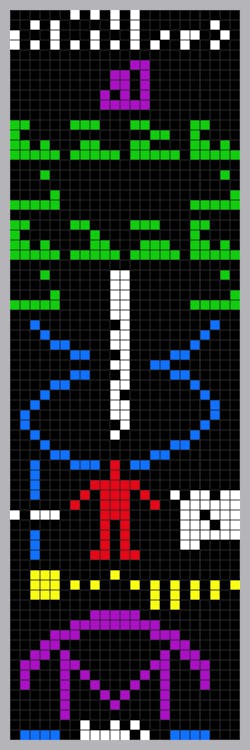The radio/radar telescope at the Arecibo Observatory in Puerto Rico was a 1,000-ft diameter dish nestled in a valley, with 900 tons of electronic gear hanging 450 feet above the dish suspended by cables from three towers.
Last August, an auxiliary cable slipped from its socket and tore a 100-ft gash in the reflector dish. Then in November, while an engineering team tried to devise a plan for repairing the damage, a three-inch main steel cable snapped. The team soon discovered that the main cable failed at about 60% of its estimated minimum breaking strength during calm weather. This led them to suspect other cables could also be weaker than expected. Apparently they were right, as the dish collapsed on Dec 1.
After the second cable failure, an engineering consulting firm came in and determined that given the risk of more cable failures, repair work on the telescope would be unsafe. Even stress tests to get more data on the remaining cables were deemed too risky. The firm eventually recommended a controlled demolition to eliminate the dangers of an unexpected collapse.
Two other consulting reams were hired to assess the situation. One thought stabilization was possible and needed to be done immediately. The other agreed that there was no way to safely verify the structure’s stability and advised against letting anyone on the telescope’s platforms or towers.
The National Science Foundation (NSF, which owns the telescope) and the University of Central Florida (which manages its day-to-day operations) had decided to play it safe and demolish the 57-year old structure. Demolition engineers were working on a controlled decommissioning that could involve helicopters and explosives, before it self-destructed.
Closing the entire facility would be a major setback for the hundreds of scientists who use the facility and graduate students who are trained there. It would also shutter one of Puerto Rico’s major tourist attractions. It typically attracted more than 90,000 visitors annually.
Staff at the observatory will work with scientists already scheduled to use the telescope to relocate their research projects wherever possible. But the Arecibo telescope and its radar capability were unique and heavily used to study near-Earth asteroids and other solar system objects. So, while some of the Arecibo science will be transferred, administrators said, some of it will not.
The NSF says that even though the telescope is demolished and unlikely to be replaced, the visitor center, an onsite atmospheric science instrument and LIDAR facility, and a second atmospheric tool that analyzes cloud cover and precipitation on the neighboring island of Culebra will continue to be used.
Arecibo Observatory’s Milestones and Discoveries
The Arecibo Observatory has been used to make a host of celestial discoveries since it came online in 1963.
- Determined Mercury rotated once every 59 days, not every 88 (1964).
- Discovered the first neutron star (1968).
- Discovered the first binary pulsar, which earned a Nobel Prize (1974).
- Transmitted the Arecibo Message (1974).
- Discovered the first millisecond pulsar (1982).
- First use of radar for imaging an asteroid (1989).
- First discovery of planets around another star (1990).
- Detected radio emissions from a T-dwarf star (2011).
The telescope was originally built for military intelligence uses. It is said it was used to locate Soviet radar installations by detecting their signals bouncing off the Moon.
Decoding the Arecibo Message
Back 1974, a group of scientists composed a message made up of encoded binary symbols, the Arecibo Message, that they wanted to send out into space. The putative goal was to contact other beings and let them know something about us – if they could decode the short and cryptic message.
In reality, it was more of a publicity stunt to tout human and U.S. technology and capabilities than a shout-out to aliens. They transmitted the message from the Arecibo Observatory and aimed it at M13, a globular star cluster 25,000 light years off in space. They chose M13 only because it was large, relatively close and would be visible in the sky when the transmission was scheduled to take place during a ceremony to mark a remodeling of the telescope on Nov 16.
The entire message consisted of 1,679 binary digits, about 210 bytes. The number 1,679 was chosen because it is a semiprime (the product of two prime numbers) and can be arranged as 73 rows and 23 columns. The alternative arrangement, 23 rows and 73 columns, creates unintelligible nonsense. The observatory transmitted the message at 2,380 MHz modulated by shifting the frequency 10 Hz, with a power of 450 kW. The “ones” and “zeros” were transmitted by frequency shifting at the rate of 10 bits per second. The total broadcast took less than three minutes.
The message consists of several “binary clues” about human life. The original message had no color; it was black-and-white. From the top:
- In white: The numbers one to ten.
- In purple: The atomic numbers of hydrogen, carbon, nitrogen, oxygen and phosphorus, the elements that make up DNA.
- In green: Formulas for the sugars and bases in DNA’s nucleotides.
- In white: The number of nucleotides in DNA.
- In blue: DNA’s double-helix structure.
- In red: Image of a human.
- In blue and white: The height of a human. These “messages” can be difficult to decode. For example, in this one, the horizontal white blocks are a binary representation of the number 14. Multiplying 14 by the message’s wavelength (126 mm) yields 1,764 millimeters, or 1.7 meters, the average height of a man.
- In white: Earth’s human population.
- In yellow: A graphic of the Solar System with the planet originating the message above the others and right below the red human figure.
In purple: A graphic of the Arecibo radio telescope with an M underneath it to indicate the antenna is concave.
In blue and white: The diameter of the transmitting antenna.




